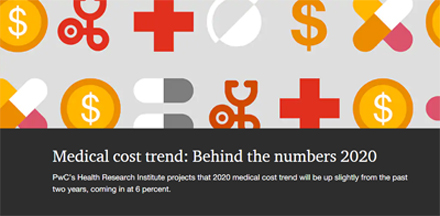Ten Takeaways From PwC’s Medical Cost Trend Behind The Numbers 2020
By Clive Riddle, June 21, 2019
PwC's Health Research Institute has just released their 14th annual report on medical cost trends: Medical cost trend: Behind the numbers 2020, which projects the 2020 trend to be a six percent cost increase. As PwC's HRI describes their 47-page report, they project "the growth of private medical costs in the coming year and identifies the leading trend drivers.... based on the best available information through June 2019. HRI conducted 55 interviews from February through June 2019 with health industry executives, health benefits experts and health plan actuaries whose companies cover more than 95 million employer sponsored large group members about their estimates for 2020 and the factors driving those trends. Also included are findings from PwC’s 2019 Health and Well-being Touchstone Survey of more than 550 employers from 37 industries as well as PwC HRI’s national consumer survey of 2,500 US adults."

Here’s Ten Takeaways from their 2020 report:
- Small Uptick: The Medical Cost trend, still rounding to double digits in 2007 (11.9%) and 2008 (9.9%), trended downwards subsequently, to round to six percent since 2016 (6.2%), but have ticked up since the low-water mark of 5.5% in 2017 (and 5.7% in 2018-2019.)
- Price, Not Utilization: “Prices have been a larger component of employer benefit costs than utilization since 2004; utilization has hovered around zero percent growth since 2006. Utilization by individuals with employer-based insurance decreased by 0.2 percent from 2013 to 2017 while prices rose 17 percent during that time.”
- Impact of High Deductibles: “Average deductibles for employer-sponsored plans tripled between 2008 and 2018. This increase likely has led to a low utilization trend because employees are delaying or forgoing care due to their deductible.”
- Stall in HDHP Growth: “The shift to HDHPs by employers seems to have stalled. With 84 percent of employers offering an HDHP option in 2019 and a tight labor market, employers may not be as quick to push HDHPs in 2020.
- Acceleration in Retail Rx Spending: “Starting in 2020, retail prescription drug spending growth for private health insurance will begin to increase, hitting between 3 percent and 6 percent annually through 2027.24 The growth in spending can be attributed to the waning impact of generics on the market and the introduction of new drugs.”
- Specialty Drug Million Dollar Drugs Pipeline: The portion of total retail drug spending on specialty drugs continues to grow. “We are at an inflection point with drugs in the pipeline. We thought hep C was expensive at nearly $100,000 per treatment. Many drugs in the pipeline are life-altering and come with a price tag of $1 million to $2 million per treatment.”
- Growth in Chronic Disease Spending: "Spending by employers on individuals with chronic diseases is nearly quadruple [3.5x] that of healthy individuals while spending on individuals with complex chronic diseases is eight times higher" [8.2x].
- Growth in Onsite Clinics: “38 percent of large employers offered an onsite health clinic in 2019, up from the 27 percent that offered a clinic in 2014. An additional 13 percent said they were considering adding one.”
- Telehealth Potential: “49 percent of consumers with employer coverage said they are willing to use telehealth in place of an in-person visit.”
- Underutilized Wellness and Prevention programs: “For decades, employers have invested in health and wellness and prevention, yet participation remains low.....The small population of employees who participate in their employers’ health and wellness programs generally believe the programs have had a positive impact on their health.”
 Post a Comment By
Post a Comment By  Riddle, Clive |
Riddle, Clive |  Friday, June 21, 2019 at 12:32PM tagged
Friday, June 21, 2019 at 12:32PM tagged  Cost & Utilization|
Cost & Utilization|  Employers|
Employers|  Surveys & Reports|
Surveys & Reports|  Trends & Strategies
Trends & Strategies 

Reader Comments